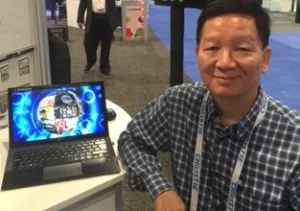Random rule #1
The impression we obtain from viewing display technology is always multiplied by great content running on its screen.
Random rule #2
Sometimes some of the most interesting learning at a conference occurs just due to happenchance. Serendipity. Call it kismet, if you will. Yes, those unanticipated and unscheduled one-off connections that can turn out to be delightful or extremely insightful.

Hao Le, Founder and CEO of Content Interface Corporation
Both of the above rules were in play at a recent conference, when I ran into Hao Le, the founder and CEO of Content Interface Corporation. He had overheard a conversation I was having with staffers at a Nokia Ozo 360 camera booth, so he pulled me aside for a one-on-one at a nearby booth that sat oddly vacated. Content Interface Corporation is a Toronto-based concern that does something very unique, something both visual and interactive that should turn heads in the display industry. His company creates a world in which, in his own words, “The content itself is interface.”
As an education writer for Display Daily, what really drew me in was the potential of this technology for learners at all levels. Apparently, education is a high priority for Hao Le, as well. He explained why in very concrete terms: “In the context of education, my wish is to have children all over the world, especially those with less privilege, enrich their live by this ‘content interface’.” “Information overload is a myth”, he emphasized. Fortunately, I recorded this entire exchange for posterity. Here’s a video of the basic idea:
Consider this technology as an interactive “infinity mirror”, giving the viewer access to information on each level or layer, through your devices or displays. Here’s a link to their YouTube page, featuring an amazing demo of their fashion industry page for Neiman Marcus, along with other interactive examples for video walls, touch signage, and even diminutive iPads:
Enough folks have already been drawn to this small company’s doorsteps. Their customer list looks like a master trophy case, including the likes of NASA, NOAA, Panasonic, Sharp, Toshiba and more.
An Impressive Customer Base
Here’s a bit more insight about their approach, which run interactively on both large and mobile displays:
Mr. Hao Le is clearly on to something here. It’s a great fit for education. Above all, this reminds me—as I know from experiences in both the 3D and VR world—that content truly matters when showcasing innovative display hardware. Showing nominal or weak content on an amazing device (tablet, wall display, mobile device, or headgear) reduces that device to its lowest common denominator—which, in this case, is the unimaginative content.
It seems as though that mistake (showing nominal content on wonderful displays) happens all too often at technology conferences. It’s one of my chief pet peeves. And the reverse is also true: unique, dynamic, visually-rich, and even a revolutionary approach to content takes the viewer to extraordinary and even unfathomable places. Kudos to Content Interface Corporation for daring to set a higher bar. –Len Scrogan

